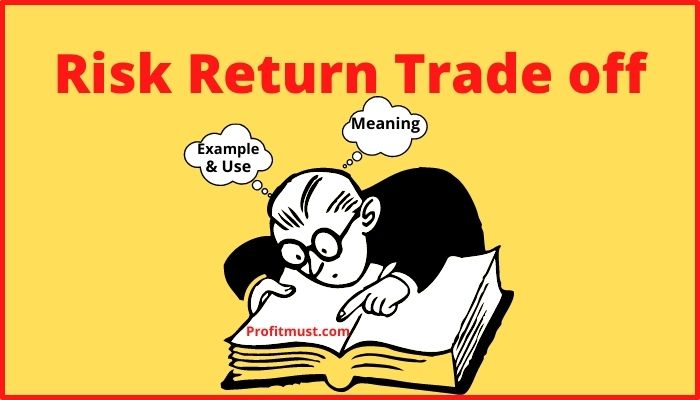To become a knowledgeable investor, you need to learn a lot more than just the fundamentals. Complex elements including risk return trade off are required to move to the next level of the investing adventure. Let’s take a closer look at it so we can properly understand it.
Table of Contents
Risk Return Trade off
The risk return trade off is a financial concept that suggests that the higher the risk, the higher the possible profit. Investors must analyze a number of aspects when calculating an acceptable risk return trade off, such as general risk tolerance, the ability to recover lost capital and much more.
When considering investment choices, investors evaluate the risk return trade off on individual assets and overall portfolios as well.
Risk Return Trade off Example
Investor X is struck with a risk reward trade off while deciding whether or not to invest. If he keeps all of his funds in a savings bank account, he will receive a minimal return (the bank’s interest rate), but all of his capital will be protected up to Rs 1 lakh.
If he invests in stocks, nevertheless, he carries the fear of losing a significant portion of his cash while still having the potential to earn a considerably higher return than a bank savings account.

Things to keep in Mind
- The risk reward trade off is a trading concept that connects significant risk with massive returns.
- The best risk return trade off is determined by a number of criteria, such as the investor’s risk tolerance, the number of years till retirement, and the ability to recover lost money.
- Time is also important in establishing a portfolio with the proper risk and return levels.
For instance, if an investor can engage in stocks for the long term, he or she will be able to recover from the concerns of bear markets and partake in bull markets, but if an investor can only invest for a limited period of time, the same stocks would have a bigger risk.
How to use Risk return trade off?
The risk return trade off is one of the most important factors that investors consider when making investment decisions and analyzing their portfolios as a whole.
At the portfolio level, the risk-return tradeoff might involve determining if the assets are extremely stable or diversified, and whether the combination offers too much threat or a lower then required return possibilities.

Analyzing Assets
When considering high-risk, high-return investments, an investor might examine the risk-return tradeoff for each asset separately and in the context of the entire portfolio.
Options, penny shares, and leveraged exchange-traded funds are instances of high-risk high-return investments (ETFs). A diversified portfolio, in principle, lowers the risks posed by particular investment holdings.
A penny share investment, for instance, may have a significant risk on its own, but if it is the only one of its sort in a bigger portfolio, the risk of owning the share is modest.
Analyzing Portfolio
At the portfolio level, the risk-reward tradeoff occurs as well. A portfolio composed entirely of stocks, for example, has a higher risk profile as well as a larger potential return.
Risk and return can be enhanced in an all-equity portfolio by focusing assets in certain industries or taking on single positions that account for a high percentage of holdings.
Evaluating the overall risk return tradeoff of all positions can help investors determine if a portfolio is taking on sufficient risk to meet long-term return goals or if the risk levels are too high with the current holdings combination.

Conclusion
To establish a portfolio that is well-balanced and safeguarded against market volatility, one should pick assets with various risk levels and rewards potential.
This is all from our side regarding Risk Return Trade off. Although, if you have any doubts you can just comment below.
Other Interesting blogs related to Risk Return Trade off.
Best Indicator for Intraday Trading
FAQ About risk and return trade off
Types of risk-return trade off?
There are 4 types metrics to measure Risk return trade off in mutual Funds: Alpha, Beta, Sharpe Ratio, and Standard Deviation.
How can a risk-return trade off concept be helpful to an investor?
Considering the overall risk reward tradeoff of all positions can help investors determine if a portfolio is taking on sufficient risk to meet long-term return goals or if the risk ratios are too high with the current holdings combination.
Importance of risk-return trade-off?
Making the right financial decisions requires a thorough knowledge of the risk-reward tradeoff. It assists you in selecting the appropriate investment option while taking into account the level of risk you are prepared to accept. It also assists in the discovery of unscrupulous investment ideas.
is risk-return trade off concept helpful to an investor?
Making the right financial decisions requires a thorough knowledge of the risk-reward tradeoff. It assists you in selecting the appropriate investment option while taking into account the level of risk you are prepared to accept. It also assists in the discovery of unscrupulous investment ideas.
How to calculate risk-return trade off?
Investors consider the alpha, beta, standard deviation, and Sharpe ratio of a mutual fund to identify its risk-return tradeoff. The mutual fund firm that is selling the investment usually makes each of these data public.

